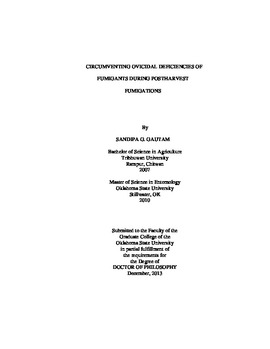| dc.description.abstract | Sulfuryl fluoride (SF) is an increasingly used methyl bromide alternative for postharvest disinfestation of United States-produced walnuts. However, eggs of several key walnut pests are not adequately controlled by this fumigant at recommended label rate. These studies were conducted in the context of overcoming ovicidal deficiencies of SF during rapid field disinfestations. The first objective was to investigate the role of egg morphology in the context of species-specific fumigant efficacies. To accomplish this, the abundance, distribution, and location of respiratory openings on eggs of Carpophilus hemipterus (L.), Tribolium castaneum (Herbst), Lasioderma serricorne (F.), Plodia interpunctella (Hubner), Ephestia elutella (Hubner), and Amyelois transitella (Walker) were compared. Chorion structures and thicknesses of these species were also compared. Presence, distribution, and location of respiratory structures varied among species. This was the case for chorionic structures and thicknesses as well. The second objective was to establish dose responses of eggs of key walnut pests, namely, C. hemipterus, T. castaneum, L. serricorne, P. interpunctella, E. elutella, A. transitella, and Cydia pomonella (L.) to propylene oxide (PPO) in combination with 100 mmHg or carbon dioxide and normal atmospheric pressure. Results showed that PPO is an effective ovicide. Mortality tests on all insect species resulted in LC99 values ranging from 24.7-167.9 mg/liter at 100 mmHg and 4.0-17.3 mg/liter in combination with carbon dioxide. Corresponding CT (concentration x time) products were 49.3-674.4 mg h/liter and 95.3-414.8 mg h/liter, respectively. In general, coleopteran eggs were more tolerant to PPO compared to lepidopteran eggs, but L. serricorne was the exception. Findings from these studies suggest that species-specific ovicidal efficacies are possibly related to surface morphology of eggs, and that chorionic respiratory structure and chorion thicknesses may differentially affect fumigant penetration/uptake. PPO efficacy data provides information on concentrations of PPO required to kill eggs of key walnut pests at reduced and normal atmospheric pressure. These toxicity data represent a critical initial step in formulating a SF-PPO blend to meet postharvest disinfestation requirements of the California walnut industry. Future research should be aimed determining the absorbance and residue levels of propylene oxide and commercial testing of the blend. | |
